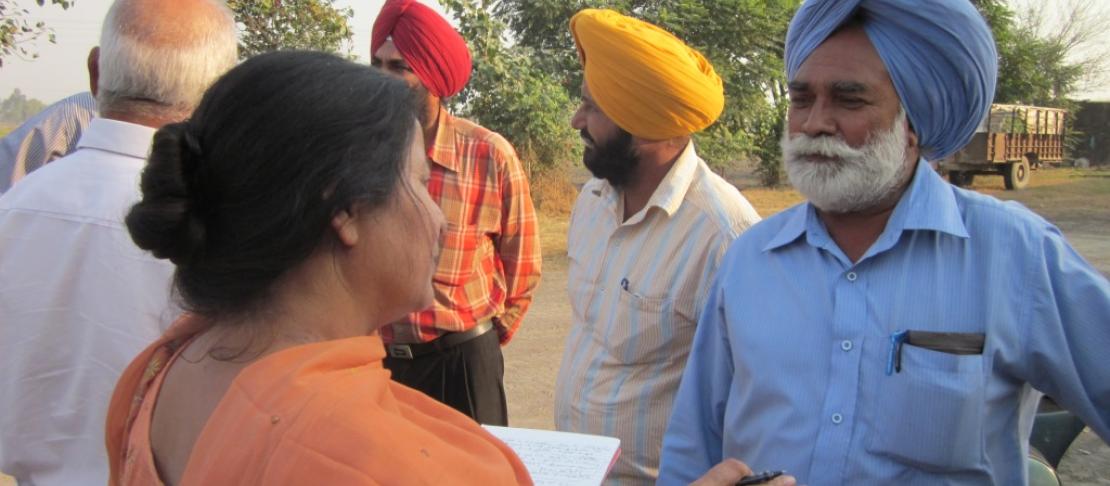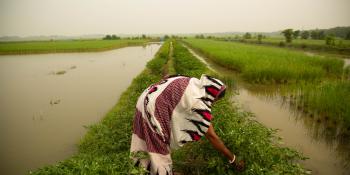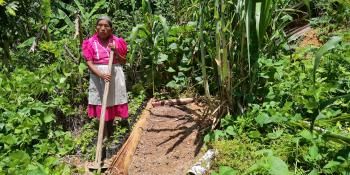Collaborating with farmers and partners in Punjab, India

Originally published on November 15 by Julian Ramirez on the CIAT-DAPA Blog.
During the last week, the CCAFS management team, steering committee and Indo-Gangetic Plains (IGP) scenarios meeting were carried out in New Delhi (India).
The regional meetings were all about understanding the demands from the region, and about understanding the specificities that should be taken into account. Rice and wheat are the main crops within this region (although fisheries also play an important role in several communities). Several within-region differences and contrasts can be found in terms of productivity, availability of resources and vulnerability. Water was found to be the most important and critical driver of rural livelihoods for the IGP: Water availability, water quality, and water management are fundamental for the sustainability of agricultural systems in within the IGP. Bearing this in mind, we, as CCAFS Research team on Adaptation through Managing Climate Risk, wanted to get into the field to investigate the problems that farmers are currently facing, so that we can tackle the relevant problems with our science.
Theme 1 is collaborating with Bioversity International’s office in India, the Directorate of Wheat Research (DWR), and the Punjab Agricultural University (PAU) to determine the key drivers of agriculture in IGP. We visited two cities in the state of Punjab: Ludhiana and Karnal. Punjab is the top producer state of wheat and rice (the two most important food security crops in India). In addition, its particular environmental characteristics make its Basmati rice to have a unique and world renowned aroma.
We learned several things from local farmers:
- Regardless of the farm size, income, or any other social factor, Punjab’s farmers depend upon: the latest variety released, the weather conditions and the most suitable management technologies for cultivation.
- Farmers acknowledge the importance of weather conditions and the possible threats that could arise from climate change
- Local agricultural science institutions attempts to keep them safe from threats by properly communicating scientific knowledge (threats ahead), and deploying, testing and releasing the most appropriate new varieties
- Farmers are keen observers and field scientists: they collaborate in any planned trial and even plan and perform their own trials
- Farmers are always open to implementing new technologies, as long as these bring an increase in yield, or a decrease in inputs costs: adopting new varieties, and improved practices and technologies.
Yet there are still vulnerabilities, such as:
- Sowing and harvest dates for both the Rabi and Kharif season are key for obtaining optimum yields, and these are highly influenced by local weather
- Conservation agriculture doesn’t seem to be widely adopted in the region, and farmers are beginning to burn the harvest residues after the cropping season, damaging the soil and the environment
- Any change in rainfall seasonality affects crop production, both for irrigated and rainfed systems, reducing yields for the present and following growing season
- Short cycle genotypes are required in some areas, but shorter cycle means less yields
- There have been several decreases in yields recently, and this is the reason for some farmers to engage in other activities outside of agriculture
- Maximum temperatures during the summer period are already up to ~40-44 °C, a 2°C increase in temperature could be critical for wheat/rice.
And they face the challenge of feeding a growing population, of sustaining production whenever climatic conditions become unsuitable, preserving the environmental and soil quality, and sustaining their own livelihoods. So, we conclude:
- Strengthening or establishing collaborations with local partners is key for both guiding science and reaching farmers in the context of climate change
- Analysing changes in rainfall seasonality and increases in maximum temperatures in summer should be the key points to address within our analyses.
- Crop improvement strategies and varietal releases must fulfill future requirements and overcome stresses
- A crop-climate forecasting system is required not only for the future, but also for the present
- Strengthening and improving communication throughout the region makes any research result usable for farmers
- Analysing trade-offs with mitigation can bring opportunities for adopting technologies such as conservation or zero tillage, and at the same time can reduce the residue burning (win-win)
- Investment is required in science and technology transfer options: funding should not be a limiting factor
- Farmers need to be actively engaged in research
So, we look towards identifying sound adaptation options together with the local partners, and exploiting their massive extension capacity to link knowledge into action. The ultimate objective is to ensure that the IGP and the food systems across the whole region stand up to the challenges of climate change. From what we have seen in these last few days, the capacity of the local actors (including the farmers themselves) is tremendous, so the future is not as bleak as some of the models make out.

